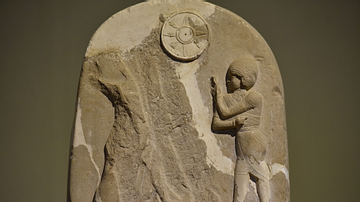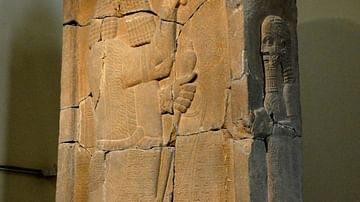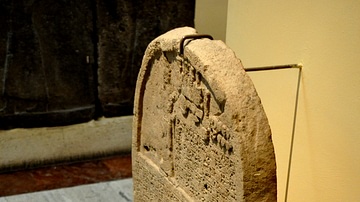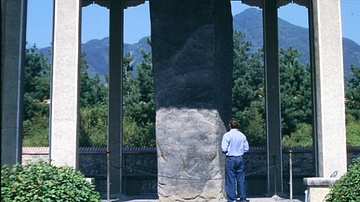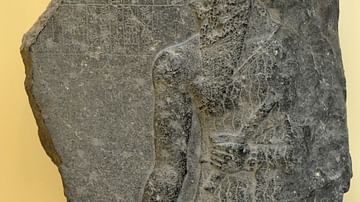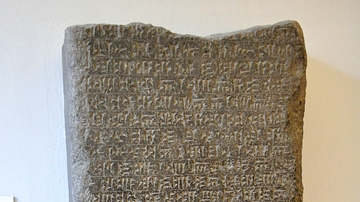Illustration
The stele is an elongated stone monument which originally stood at the Temple of Adad at Eshnunna. The front side is carved with four registers while the narrow sides were inscribed with 220 lines of a cuneiform text divided into 17 columns. Dadudha was a king of Eshnunna and this stele commemorates his victory over the city of Qabara in Arbela (modern-day Erbil, in Iraqi Kurdistan) and its king Banu-Ishtar, with the help of king Shamshi-Addu of Ekallatum.
The stele was found accidentally in 1983 CE while digging out a well in the outskirts of ancient Eshnunna (modern-day Tell Asmar) in Diyala Governorate, Iraq. The center of the front side was damaged during the discovery.
This is the upper register (the image of heroism) which shows Dadudha (left) in a position of a slayer, standing over the slain king of Qabara, Banu-Ishtar. A standing male figure (right) adores Dadusha; this is probably a crown-prince or a military general. The sun-disc with its rays of Shamash, combined with the crescent of Sin, appears at the central upper part.
At the bottom of the image, the city walls of Qabara appears. Old-Babylonian period, 1830-1760 BCE. It is on display at the Iraq Museum in Baghdad, Republic of Iraq.
About the Author
Cite This Work
APA Style
Amin, O. S. M. (2019, May 21). Stele of Dadusha, King of Eshnunna. World History Encyclopedia. Retrieved from https://www.worldhistory.org/image/10751/stele-of-dadusha-king-of-eshnunna/
Chicago Style
Amin, Osama Shukir Muhammed. "Stele of Dadusha, King of Eshnunna." World History Encyclopedia. Last modified May 21, 2019. https://www.worldhistory.org/image/10751/stele-of-dadusha-king-of-eshnunna/.
MLA Style
Amin, Osama Shukir Muhammed. "Stele of Dadusha, King of Eshnunna." World History Encyclopedia. World History Encyclopedia, 21 May 2019. Web. 30 Mar 2025.



